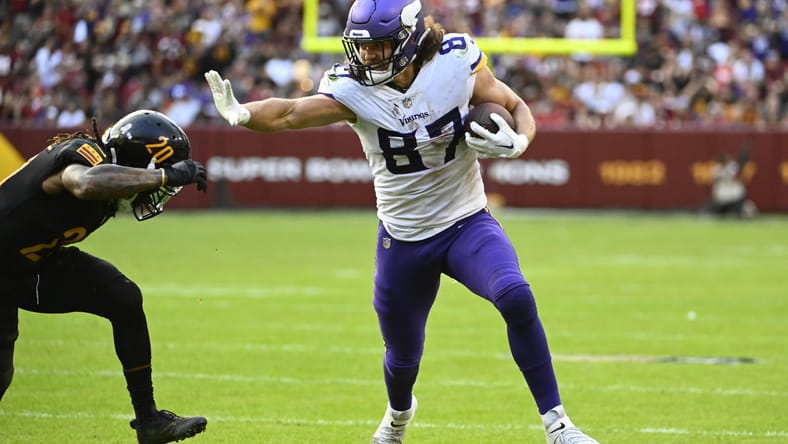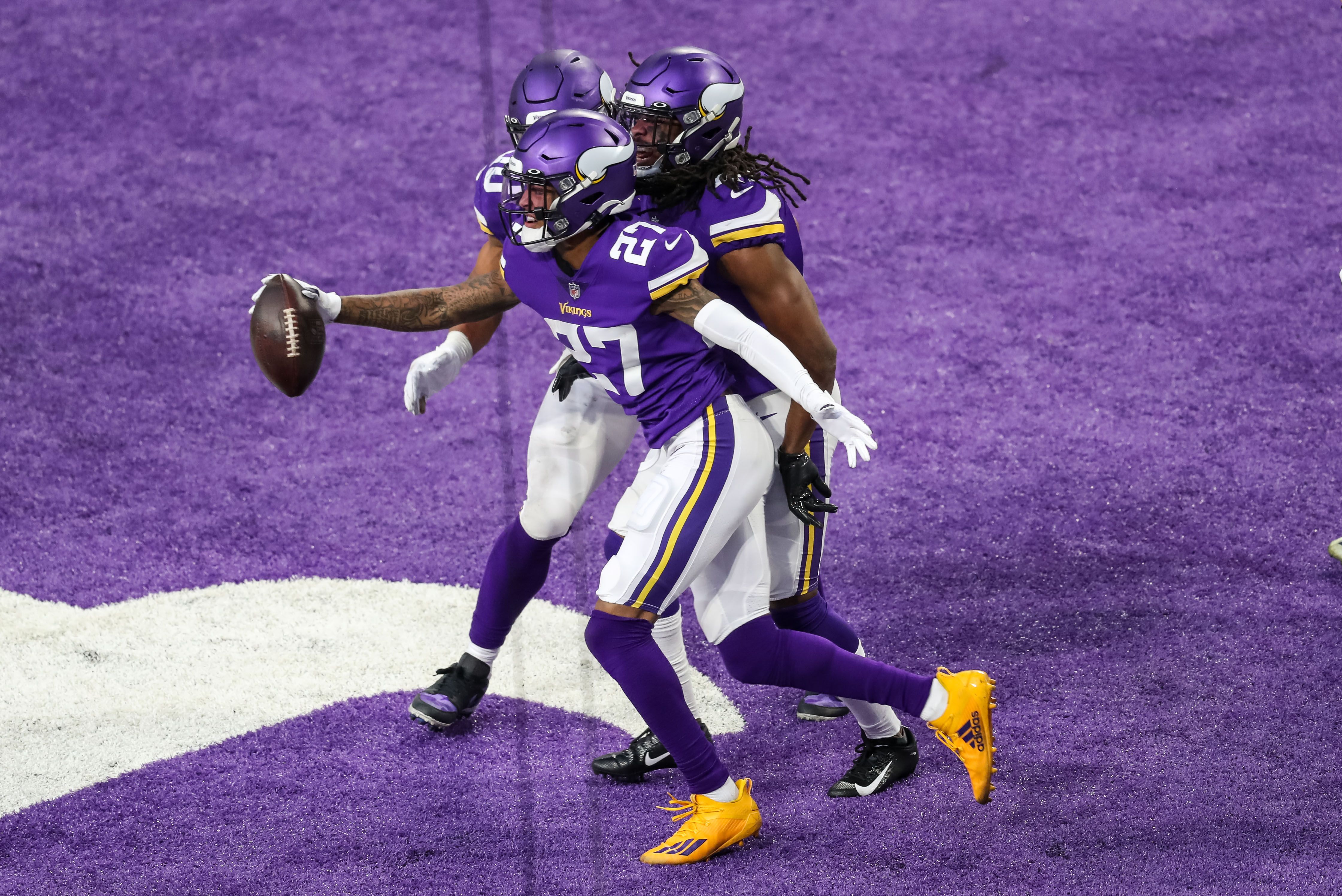How Has the T.J. Hockenson Trade Improved the Vikings After 5 Games?

As the Minnesota Vikings get ready to travel to Ford Field this week for a rematch with the Detroit Lions, it is natural to take a look at how the T.J. Hockenson trade has affected each team. The two NFC North rivals made the trade hours before the trade deadline, once again showing that new general manager Kwesi Adofo-Mensah isn’t shy about making deals with division foes.
At the time of the trade, the Vikings were a surprising 6-1 and in line for the NFC’s second seed. However, they had lost starting tight end Irv Smith, Jr. for the season one week prior. Not much has changed for them in the NFC standings since then, as they have gone 4-1 since the trade and appear to be locked into the second seed come playoff time. The Lions, meanwhile, were a disappointing 1-6 after off-season hype that they could finally turn their fortunes around. However, they, too, have gone 4-1 since the trade, clawing their way to a 5-7 record and are making ground on the final wild card spots in the NFC.
But how are the two teams performing at tight end since the trade? With each team winning four games since the trade, it might be safe to assume that the Lions are replacing their lost production from Hockenson with other tight ends. I decided to crunch the numbers and see how each team has performed at tight end since the trade.
T.J. Hockenson Before and After the Trade
It is still somewhat puzzling that the Lions decided to trade away their former first-round tight end. In seven games, Hockenson had caught 26 of 41 targets (63.4%) for three touchdowns. He averaged 15.2 yards per reception as he totaled 395 yards while adding three touchdowns.
Despite arriving in Minnesota on a short week, Hockenson was thrust into a large role against the Washington Commanders. He caught all nine passes thrown his way for 70 yards. In five games with the Vikings, Hockenson has caught 30 of 38 targets for 225 yards and one touchdown.
Lions Tight Ends Before and After the Trade
With Hockenson carrying the weight in the Lions’ tight end room, their other contributors had limited roles. Brock Wright caught six passes for 88 yards before the trade. James Mitchell had one reception for 14 yards. And Shane Zylstra was shut out, only playing 16 total offensive snaps prior to the trade.
Although all three tight ends have seen jumps in playing time since the Hockenson trade, it hasn’t translated to much success in the air. Wright only has seven receptions for 53 yards and a touchdown since the trade. Mitchell has caught four passes for 34 yards. And Zylstra has added only two receptions for five yards, being used mostly as a blocker.
Vikings Tight Ends Before the Trade
Before acquiring Hockenson, the Vikings were using a tight-end-by-committee approach. Johnny Mundt, who was with head coach Kevin O’Connell in Los Angeles, joined the Vikings during the off-season. He had caught only 10 passes for 93 yards in his five years with the Rams, so he was viewed as little more than a blocking tight end entering the season. That ended up not entirely being the case.
Mundt caught seven passes for 68 yards in the first three games of the 2022 season. He played 65% of offensive snaps in Week 1 against the Green Bay Packers while Irv Smith, Jr., the presumed starter, played only 31% of the offensive snaps (more on him in a minute). However, Mundt’s production reverted back to what fans expected all along. From Weeks 4-8, Mundt caught six passes for a measly nine yards.
Smith, meanwhile, spent the off-season recovering from a torn meniscus suffered in the Vikings’ final preseason game of the 2021 season. Then during training camp this season, he injured his thumb, keeping him out of practice as the calendar ramped up to Week 1.
After his limited playing time against the Packers in the season opener (where he was held without a catch), Smith dropped a wide-open pass against the Philadelphia Eagles on Monday Night Football. On other plays, he failed to gain separation from linebackers when precious third-down opportunities arose. This foreshadowed a disappointing beginning to Smith’s season, as he caught 22 of 31 targets for 168 yards and two touchdowns.
Smith’s season ended when he suffered a high-ankle sprain against the Arizona Cardinals. The team’s other tight end, Ben Ellefson, caught three passes for 26 yards before landing on injured reserve following Week 4.
How Has Hockenson Improved the Vikings Tight End Room?
The Vikings have made it no secret that they want Hockenson to get involved in the offense. But when looking at advanced metrics, we see how much more effective he has been than what the Vikings had previously. These numbers are all from Pro Football Focus (PFF).
| Hockenson (5 games) | Statistic | Smith (7 games) |
| 81 times (39.7%) | Line Up In Slot In Pass Plays | 43 times (21.6%) |
| 93 (3.1 yards/rec) | Yards After Catch | 92 (4.2 yards/rec) |
| 1.28 | Yards Per Route | 1.01 |
| 6.0 yards | Average Depth of Target | 5.4 yards |
| 5/9 (55.6%) | Contested Catches | 0/3 (0%) |
| 14 | 1st Downs | 9 |
| 91 | Total Run Blocks | 54 |
| 68.4 | Run Block Grade | 58.0 |
Hockenson has been used all over the field with the Vikings. He is lining up in the slot more often that Smith was, allowing him to take advantage of holes in the defense. His overall production is higher than Smith’s across the board.
Most notable, though, is that he has been used in the running game 37 more times than Smith despite playing two fewer games. Not only that, but he has been a more effective blocker than Smith. Because of this, the Vikings don’t have to substitute Hockenson out on run plays, an obvious “tell” for defenses. This allows the offense to be more unpredictable as Hockenson is as well-suited to block as he is to run a route.
This isn’t by accident, either. Hockenson wasn’t as effective in the Lions’ “gap-scheme” running game. In Minnesota, where they run a heavy “zone” rushing attack, Hockenson is able to play more to his strengths. This trade by the Vikings was intentional not only because they knew how Hockenson could improve their passing attack but also how they could get the most out of his run-blocking.
Perhaps this is why the Lions were so willing to trade Hockenson within their division. According to PFF, four of the Lions’ six best run-blocking games have come since Week 9. Owners of the 10th-best rushing offense in football, the Lions know their offense will go only as far as their dynamic running game will take them.
Conclusion
While the raw numbers may not show that the Lions are replacing T.J. Hockenson’s production in the air, they may have believed that he was hindering their rushing attack. Meanwhile, Hockenson has added a more dynamic and consistent threat to a Vikings offense loaded with weapons. So far, the trade hasn’t appeared to hurt the Lions while it has helped the Vikings. Sunday could further add clarity to who won this trade.
[brid autoplay=”true” video=”1201644″ player=”26281″ title=”WATCH%20NFL%20Week%2013%20winners%20&%20losers” duration=”108″ description=”NFL Week 13 was billed as one of the best slates in weeks. Thanks to some fantastic matchups and jaw-dropping performances, we’ve got plenty of winners and losers to reflect upon from Sunday’s action.” uploaddate=”2022-12-06″ thumbnailurl=”https://cdn.brid.tv/live/partners/17660/snapshot/1201615_sd_1670370801.jpg” contentUrl=”https://cdn.brid.tv/live/partners/17660/streaming/1201615/1201615.m3u8″ width=”16″ height=”9″]

